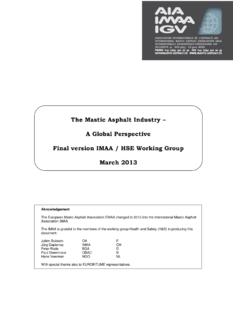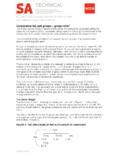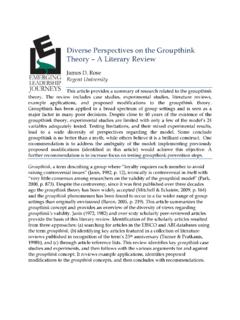Transcription of The Mastic Asphalt Industry – A Global Perspective …
1 The Mastic Asphalt Industry A Global Perspective The Mastic Asphalt Industry A Global Perspective Final version EMAA / HSE Working group November 2010 Acknowledgement The EMAA is grateful to the members of the working group Health and Safety (H&S) in producing this document: Julien Buisson OA F J rg Depierraz EMAA CH Pierre Pannetier OA F Peter Rode BGA D Paul Steenmans OBAC B Denzil Udell MAC GB With special thanks also to EUROBITUME representatives. November 2010 page 1 of 29 The Mastic Asphalt Industry A Global Perspective The Mastic Asphalt Industry A Global Perspective Content 1. Description of the product.
2 3 2. Fields of application ..3 Bridge Flooring (building)..4 Flooring (industrial)..5 Road construction ..5 Rooftop car parks ..6 Hydraulic constructions ..7 Flat 3. History and production levels ..8 4. Production methods ..9 Mastic Asphalt mixing processes ..9 Definition of the components used in manufacture ..12 Binders: types ..12 Paving grade bitumen (complying with EN 12591)..12 Hard Grade Industrial bitumen (complying with EN 13305) and hard Paving Grade bitumen (complying with EN 13924).
3 12 Synthetic pigmentable binder ..13 Binders: contents ..13 Binders: additives ..13 Addition of polymers (complying with EN 14023) ..13 Addition of natural Asphalt ..13 Addition of wax derivatives ..14 Addition of pigments ..14 Addition of fibres (in combination with the addition of natural Asphalt ) ..14 Fillers ..14 Mineral aggregates ..15 Limestone Fine Coarse aggregates.
4 15 5. Transport ..17 6. Application Hand applied ..18 Machine applied ..19 Temperatures of 7. Occupational exposure ..21 Exposure Monitoring of bitumen Bitumen fumes defined ..21 Occupational Exposure Monitoring for Asphalt Fumes ..22 Exposure during placement of Mastic PAH exposures while handling Mastic 8. Summary and November 2010 page 2 of 29 The Mastic Asphalt Industry A Global Perspective The Mastic Asphalt Industry A Global Perspective 1. Description of the product Mastic Asphalt (MA) is a dense mixture consisting of coarse aggregate, and/or sand, and /or limestone fine aggregate, and/or filler and bitumen, which may contain additives (for example polymers, waxes).
5 The mixture is designed to be of low void content. The binder content is so adjusted that the voids are completely filled and that even a slight excess of binder may occur. Mastic Asphalt is pourable and able to be spread in its working temperature condition. It requires no compaction on site. On the other hand Asphalt Mastic abbreviation AM is a term used in Europe to describe a mix of sand (that is, without aggregates > 2 mm), and/or limestone fine aggregate, and/or filler and bitumen that is used specially for waterproofing in a variety of applications. The formulation of the mixture is chosen as a function of field of application mechanical load thermal load chemical load climatological influences.
6 2. Fields of application Bridge decks Bridge deck pavements must comply with a large number of conditions, such as: waterproof-ing, stability against deformation, rugosity, smoothness, aging, etc. The paving must protect the underlying supporting structure against external influences and, therefore, this deter-mines to a great extent the lifetime of the construction. It must withstand the heavy load of traffic and weather conditions. When the supporting structure is made of concrete, it must be protected against the effects of de-icing salt. On steel bridge decks the paving has the func-tion of protecting against corrosion.
7 It has been sufficiently proven in the past that, for several reasons, in the long run, immedi-ate reopening of the road is impossible on a concrete bridge deck without Asphalt paving. Bituminous paving, on the other hand, has demonstrated to be particularly suitable as a re-sult of its visco-elastic properties. Indeed, by installing relatively thin pavements it becomes possible to economically design and build bridges, because the permanent load of the pav-ing is restricted. Traditional Asphalt paving cannot be bonded directly on a concrete or steel base, and neither is it waterproof, so that an intermediate waterproofing layer is necessary. This waterproofing layer must, as a rule, cover the full surface of the bridge deck.
8 Because of possible creeping, nowadays waterproofing layers must be placed to bond completely to the structure. November 2010 page 3 of 29 The Mastic Asphalt Industry A Global Perspective In order to fully waterproof a structure, a double layer system is absolutely required. Indeed, possible local imperfections cannot be excluded. By applying a second layer, possible fail-ures can be corrected and in this manner a waterproof system is achieved. For concrete bridge decks (but also for steel bridge decks!) the most common built-up sys-tem consists of: a bituminous sheet (thickness: 4 to 5 mm) bonded completely to the base by torching, a protective layer of Mastic Asphalt (thickness: 30 to 35 mm) which also has the function of a complementary waterproofing layer.
9 In some cases the bituminous membrane is replaced by a liquid resin system. For various reasons, in some countries preference is given to a traditional Asphalt concrete layer as protection for the waterproofing layer. The road paving, consisting of Mastic Asphalt or hot rolled Asphalt , is then placed on the top of the protective layer (with a possible level-ling layer). Flooring (building) In some European countries Mastic Asphalt is used as a floating screed in private and public buildings. The relevant standard for this application is EN 13318. So, this type of screed is installed directly or with thermal isolation, on the supporting construction.
10 If desired, floor heating could be incorporated and floor covering with all kinds of materials (carpeting, par-quet, linoleum, tiles, etc.) is possible. Mastic Asphalt is chosen for a large number of advantages that are very important in building construction: no additional water is added to the building, making the overall drying time of the con-struction drastically shorter can be put into use directly after cooling (this is usually after a few hours!), making the construction time considerably shorter can, to a considerable extent, be placed irrespective of weather conditions ( frost) has excellent thermal properties, making it possible to comply, in combination with ther-mal isolation and in thin layers, with heat management requirements is completely workable and contains no tar or phenol is placed jointlessly (also on large areas!)







